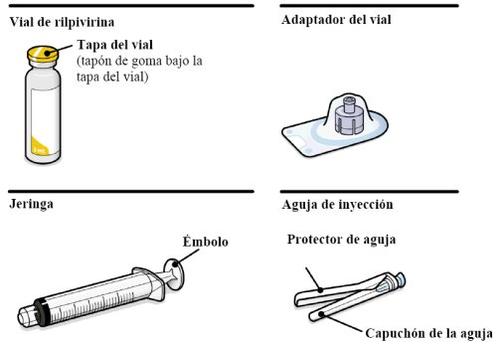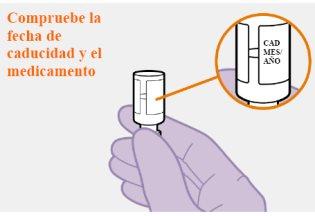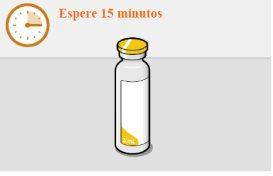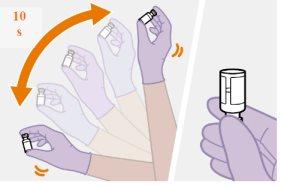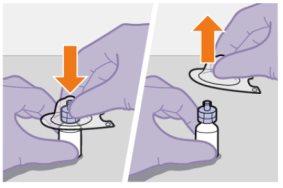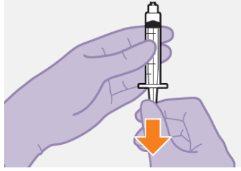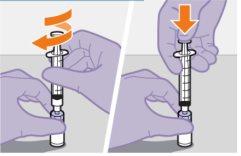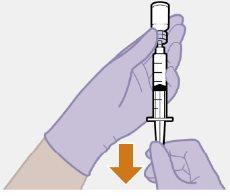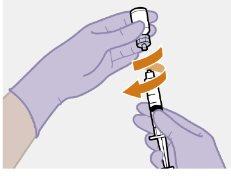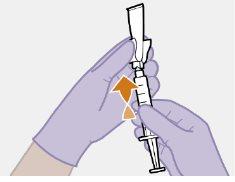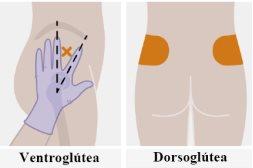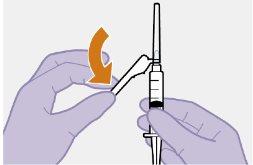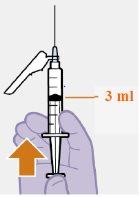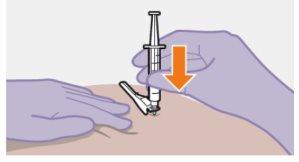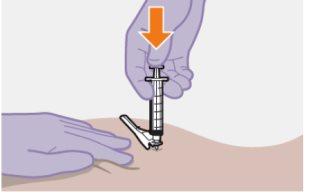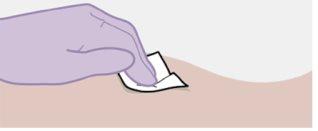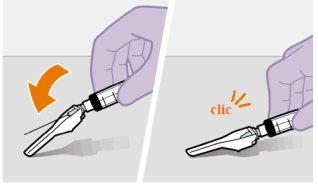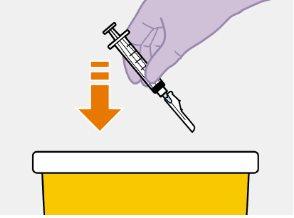
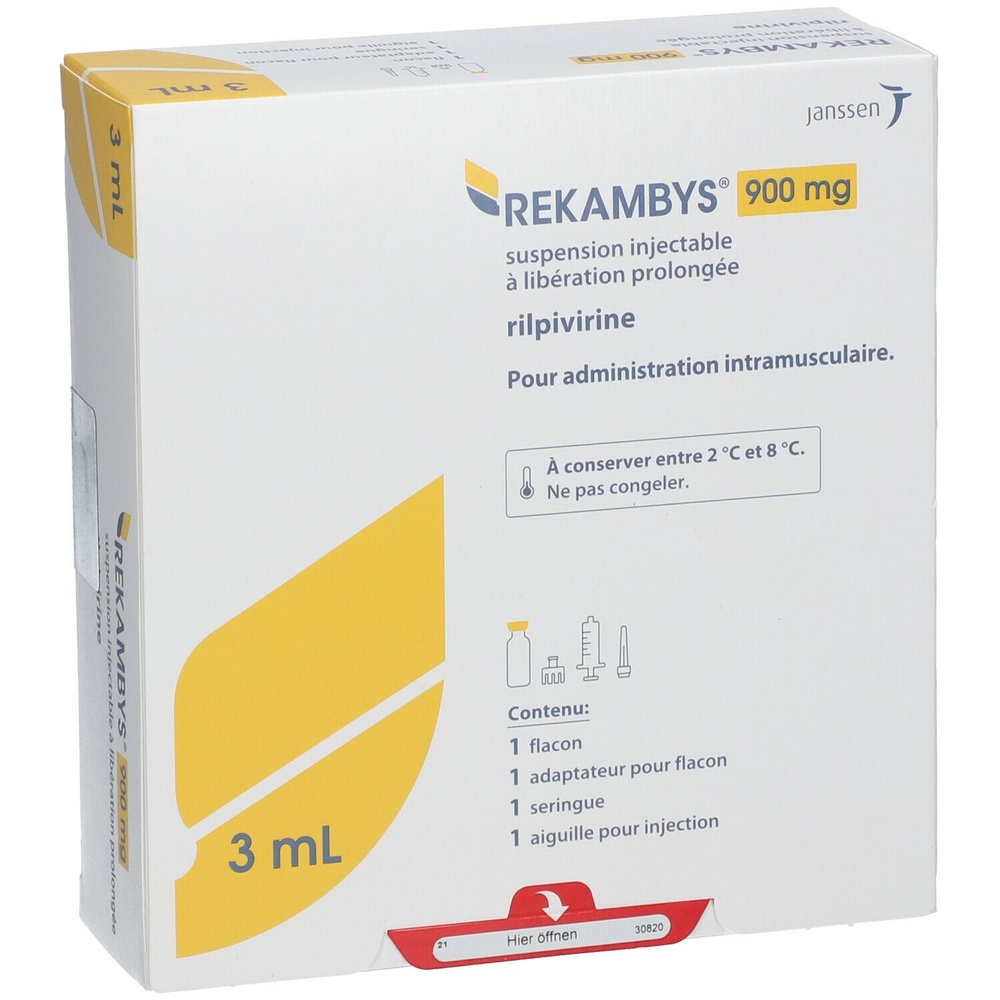
REKAMBYS 900 MG SUSPENSÃO INJETÁVEL DE LIBERTAÇÃO PROLONGADA

Pergunte a um médico sobre a prescrição de REKAMBYS 900 MG SUSPENSÃO INJETÁVEL DE LIBERTAÇÃO PROLONGADA

Como usar REKAMBYS 900 MG SUSPENSÃO INJETÁVEL DE LIBERTAÇÃO PROLONGADA
Introdução
Prospecto: informação para o paciente
REKAMBYS 900 mg suspensão injetável de libertação prolongada
rilpivirina
Este medicamento está sujeito a acompanhamento adicional, o que agilizará a detecção de nova informação sobre a sua segurança. Pode contribuir comunicando os efeitos adversos que possa ter. A parte final da seção 4 inclui informação sobre como comunicar esses efeitos adversos.
Leia todo o prospecto detenidamente antes de começar a usar este medicamento, porque contém informação importante para si.
- Conserva este prospecto, porque pode ter que voltar a lê-lo.
- Se tiver alguma dúvida, consulte o seu médico ou farmacêutico.
- Este medicamento foi prescrito apenas para si, e não deve dá-lo a outras pessoas, mesmo que tenham os mesmos sintomas que si, porque pode prejudicá-las.
- Se experimentar efeitos adversos, consulte o seu médico ou farmacêutico, mesmo que se trate de possíveis efeitos adversos que não aparecem neste prospecto. Ver seção 4.
Conteúdo do prospecto
- O que é REKAMBYS e para que se utiliza
- O que precisa saber antes de começar a usar REKAMBYS
- Como se administra REKAMBYS
- Possíveis efeitos adversos
- Conservação de REKAMBYS
- Conteúdo do envase e informação adicional
1. O que é REKAMBYS e para que se utiliza
REKAMBYS contém o princípio ativo rilpivirina. Faz parte de um grupo de medicamentos denominados inibidores da transcriptase inversa não análogos de nucleósidos (ITINAN) que se utilizam no tratamento do vírus da imunodeficiência humana tipo 1 (VIH-1).
REKAMBYS actua juntamente com outros medicamentos contra o VIH bloqueando a capacidade do vírus de fazer mais cópias de si mesmo. REKAMBYS injetável não cura a infecção por VIH, mas ajuda a reduzir a quantidade de VIH no seu corpo e a mantê-la a um nível baixo. Assim, frena o dano ao sistema imunitário e o desenvolvimento de infecções e doenças associadas à SIDA.
REKAMBYS sempre se administra com outro medicamento contra o VIH que se chama cabotegravir injetável. São administrados juntos em adultos a partir dos 18 anos cuja infecção por VIH-1 já está controlada.
2. O que precisa saber antes de começar a usar REKAMBYS
Não use REKAMBYSse for alérgico a rilpivirina ou a algum dos outros componentes deste medicamento (incluídos na seção 6).
Não use REKAMBYS se estiver tomando algum dos medicamentos seguintes, porque podem afetar a forma como REKAMBYS ou os outros medicamentos actuam:
- carbamazepina, oxcarbazepina, fenobarbital, fenitoína (medicamentos para tratar a epilepsia e prevenir as convulsões)
- rifabutina, rifampicina, rifapentina (medicamentos para tratar infecções bacterianas como a tuberculose)
- dexametasona (um corticosteroide que se utiliza para tratar diversas patologias, tais como a inflamação e as reacções alérgicas) administrada em um ciclo de tratamento por via oral ou injetável
- produtos que contêm Erva de São João ou Hipérico (Hypericum perforatum,uma planta medicinal que se utiliza para a depressão).
Se estiver tomando algum dos medicamentos anteriores, consulte o seu médico sobre as alternativas.
Advertências e precauções
Consulte o seu médico ou farmacêutico antes de começar a usar REKAMBYS.
REKAMBYS não cura a infecção por VIH. Faz parte de um tratamento para reduzir a quantidade de vírus no sangue. Enquanto estiver usando este medicamento, ainda pode transmitir o VIH aos outros, embora o risco se reduza com o tratamento antiviral eficaz. Consulte o seu médico sobre as precauções que deve tomar para não infectar outras pessoas.
Informar ao médico sobre a sua situação
Revise os seguintes pontos e informe ao seu médico se se encontrar em algum dos seguintes casos.
- Deve comparecer a todas as visitas programadas para as injeções, não falte a nenhuma visita, é muito importante para o sucesso do seu tratamento. Se não puder comparecer a uma visita programada, informe ao seu médico o mais cedo possível.
- Informar ao médico se tem ou teve alguma vez doenças do fígado, incluídas a hepatite B ou a hepatite C, ou doenças dos rins. O seu médico provavelmente verificará como o seu fígado e rins funcionam para decidir se pode usar REKAMBYS. Consulte os sinais de dano hepático na seção 4 deste prospecto “Efeitos adversos pouco frequentes”.
- Informar ao médico imediatamente se observar algum sintoma de infecção(por exemplo, febre, calafrios, suores). Em alguns pacientes com VIH, pode ocorrer inflamação devido a infecções previas pouco após iniciar o tratamento contra o VIH. Acredita-se que esses sintomas se devem à melhoria da resposta imunitária do organismo, o que permite combater as infecções presentes anteriormente, mas que não haviam manifestado sintomas evidentes.
- Informar imediatamente ao médico se observar qualquer sintoma como, por exemplo, fraqueza muscular, fraqueza que começa nas mãos e pés e que ascende em direção ao tronco do corpo, palpitações, tremores ou hiperatividade. Isso se deve a distúrbios autoimunes (condições em que o sistema imunitário ataca por engano tecido corporal saudável) que também podem ocorrer após o início do tratamento com medicamentos para o tratamento da infecção por VIH. Os distúrbios autoimunes podem aparecer muitos meses após o início do tratamento.
- Informar ao médico se estiver tomando algum medicamento que possa causar um batimento irregular do coração potencialmente mortal (torsade de pointes).
Reacções às injeções
Algumas pessoas experimentaram sintomas de reacções posteriores à injeção a poucos minutos de receber a injeção de rilpivirina. A maioria dos sintomas resolveu-se dentro de minutos após a injeção. Os sintomas das reacções posteriores à injeção podem incluir: dificuldade para respirar, cãibras estomacais, suor, formigamento da boca, sensação de ansiedade, sensação de calor, sensação de tontura ou de que se vai desvanecer (ou desmaiar) e alterações na pressão arterial. Informar ao profissional de saúde se experimentar esses sintomas após receber as injeções.
É importante comparecer pontualmente às consultas
É importante que compareça às suas consultas programadaspara receber REKAMBYS e controlar a sua infecção por VIH e para evitar que a doença piore. Não falte a nenhuma das visitas, é muito importante para que o tratamento seja eficaz. Se não puder comparecer a uma visita programada, informe ao seu médico o mais cedo possível. Informe ao médico se está pensando deixar o tratamento. Se a administração de REKAMBYS for retardada, ou se deixar de receber REKAMBYS, deverá tomar outros medicamentos para tratar a infecção por VIH e reduzir o risco de que o vírus se torne resistente, porque os níveis de medicamento no seu corpo serão demasiado baixos para tratar a infecção por VIH.
Crianças
REKAMBYS não é para uso em crianças ou adolescentes menores de 18 anos de idade, porque não foi estudado nesses pacientes.
Outros medicamentos e REKAMBYS
Informar ao profissional de saúde se estiver tomando, tomou recentemente ou possa ter que tomar qualquer outro medicamento. Alguns medicamentos podem afetar o nível de REKAMBYS no sangue se os tomar durante o tratamento com REKAMBYS, ou REKAMBYS pode afetar a eficácia dos outros medicamentos.
Não use REKAMBYS se estiver tomando algum dos medicamentos seguintes, porque podem afetar a forma como REKAMBYS ou os outros medicamentos actuam:
- carbamazepina, oxcarbazepina, fenobarbital, fenitoína (medicamentos para tratar a epilepsia e prevenir as convulsões)
- rifabutina, rifampicina, rifapentina (medicamentos para tratar infecções bacterianas como a tuberculose)
- dexametasona (um corticosteroide que se utiliza para tratar diversas patologias, tais como a inflamação e as reacções alérgicas) administrada em um ciclo de tratamento por via oral ou injetável
- produtos que contêm Erva de São João ou Hipérico (Hypericum perforatum,uma planta medicinal que se utiliza para a depressão).
Se estiver tomando algum dos medicamentos anteriores, consulte o seu médico sobre as alternativas.
O efeito de REKAMBYS ou de outros medicamentos pode mudarse usar REKAMBYS com algum dos seguintes medicamentos:
- claritromicina, eritromicina (antibióticos)
- metadona (que se utiliza para tratar o síndrome de abstinência e a dependência)
Gravidez e lactação
Informar ao médico imediatamente se estiver grávida ou tiver intenção de engravidar. O seu médico avaliará o benefício e o risco, para si e para o seu bebê, do uso de REKAMBYS durante a gravidez. Se tiver intenção de engravidar, consulte o seu médico previamente, porque rilpivirina pode permanecer no organismo até 4 anos após a última injeção de REKAMBYS.
As mulheres que têm VIH não devem amamentar porque o VIH pode ser transmitido através do leite materno e infectar o bebê.
Consulte o seu médico ou farmacêutico antes de tomar qualquer medicamento.
Condução e uso de máquinas
Alguns pacientes podem sentir cansaço, tontura ou sonolência durante o tratamento com REKAMBYS. Não conduza nem utilize máquinas se sofrer algum desses efeitos adversos.
Informação importante sobre alguns dos componentes de REKAMBYS
Este medicamento contém menos de 1 mmol de sódio (23 mg) por 3 ml de injeção; isto é, é essencialmente “isento de sódio”.
3. Como se administra REKAMBYS
Um enfermeiro ou médico lhe administrará REKAMBYS como uma injeção no músculo da nádega (injeção intramuscular, ou IM).
A injeção será administrada uma vez por mês ou uma vez cada 2 meses,juntamente com outro medicamento injetável que se chama cabotegravir. O seu médico explicará com que frequência lhe será administrado o medicamento.
Antes de começar o tratamento com REKAMBYS, o seu médico prescreverá um tratamento diário com comprimidos de rilpivirina e cabotegravir durante um mês. Isso é conhecido como dosageminicial oral;tomando os comprimidos antes de receber as injeções de RECAMBYS e cabotegravir permitirá ao seu médico verificar se esses medicamentos são adequados para si.
Se lhe forem administrar REKAMBYS uma vez por mês, o seu tratamento será o seguinte:
Quando | |||
Medicamento | Mês 1 (pelo menos 28 dias) | Mês 2 (após um mês de comprimidos) | A partir do mês 3 |
Rilpivirina | Comprimido de 25 mg uma vez por dia | Uma injeção de 900 mg | Injeção de 600 mg cada mês |
Cabotegravir | Comprimido de 30 mg uma vez por dia | Uma injeção de 600 mg | Injeção de 400 mg cada mês |
Se lhe forem administrar REKAMBYS cada 2 meses, o seu tratamento será o seguinte:
Quando | |||
Medicamento | Mês 1 (pelo menos 28 dias) | Mês 2 (após um mês de comprimidos) e mês 3 | A partir do mês 5 |
Rilpivirina | Comprimido de 25 mg, uma vez por dia | Uma injeção de 900 mg | Injeção de 900 mg cada 2 meses |
Cabotegravir | Comprimido de 30 mg, uma vez por dia | Uma injeção de 600 mg | Injeção de 600 mg cada 2 meses |
Se omitir uma injeção de REKAMBYS
É importante que compareça regularmente às suas consultas programadas para receber a sua injeção. Se não comparecer a uma consulta, entre em contacto com o seu médico imediatamente para concertar outra.
Informar ao médicose acreditar que não vai poder receber a injeção de REKAMBYS na data prevista. O seu médico pode recomendar que tome comprimidos até que lhe possam administrar uma injeção de REKAMBYS novamente.
Se lhe administrarem demasiado REKAMBYS
Um médico ou enfermeiro lhe administrará este medicamento, por isso é improvável que lhe administrem demasiado. Se estiver preocupado, diga ao médico ou enfermeiro.
Não deixe de usar REKAMBYS sem que o seu médico o recomende.
Use REKAMBYS todo o tempo que o seu médico o indicar. Não interrompa o tratamento a não ser que o seu médico o aconselhe.
Após interromper o tratamento, podem permanecer níveis baixos de rilpivirina (o princípio ativo de REKAMBYS) no seu corpo durante até 4 anos. No entanto, após a última injeção de REKAMBYS, os níveis baixos de rilpivirina que permanecem não serão suficientes para combater o vírus e podem torná-lo resistente. Para manter a infecção de VIH-1 sob controlo e evitar que o vírus se torne resistente, deve começar um tratamento diferente contra o VIH na data em que estivesse prevista a próxima injeção de REKAMBYS.
4. Possíveis efeitos adversos
Como todos os medicamentos, este medicamento pode produzir efeitos adversos, embora nem todas as pessoas os sofram.
A seguir, encontrará uma lista dos efeitos adversos que foram descritos com o uso de REKAMBYS e cabotegravir injetável.
Efeitos adversos muito frequentes (afetam pelo menos 1 de cada 10 pessoas)
- dor de cabeça
- reações no local da injeção - habitualmente são de leves a moderadas e a sua frequência diminui com o tempo. Os seus sintomas podem incluir:
o muito frequentes: dor e molestias, massas ou bultos duros
o frequentes: vermelhidão, picazão, inchaço, hematomas, calor ou alteração de cor.
o pouco frequentes: entorpecimento, sangramento leve, formação de abscesso (acumulação de pus) ou celulite (com sensação de calor, inchaço ou vermelhidão).
- Sensação de calor/febril (pirexia)
Efeitos adversos frequentes (afetam menos de 1 de cada 10 pessoas)
- depressão
- ansiedade
- sonhos anormais
- dificuldade para dormir (insónia)
- tonturas
- sensação de mal-estar (náuseas)
- vómitos
- dor de barriga (dor abdominal)
- gases (flatulência)
- diarreia
- erupção cutânea
- dor muscular (mialgia)
- cansaço (fadiga)
- sensação de fraqueza (astenia)
- mal-estar geral
- aumento de peso
Efeitos adversos pouco frequentes (afetam menos de 1 de cada 100 pessoas)
- entorpecimento (sonolência)
- sensação de tontura durante ou após uma injeção. Isso pode provocar desmaios.
- dano hepático (os seus sinais podem incluir coloração amarela da pele e da parte branca do olho, perda do apetite, picazão, dor à palpação da barriga, fezes de cor clara ou urina de cor anormalmente escura).
- alterações nos níveis analíticos de função hepática (aumento das transaminases)
- aumento da bilirrubina(uma substância produzida pelo fígado) no sangue.
Outros efeitos adversos
- Dor abdominal intensa causada por inflamação do pâncreas (pancreatite).
Os seguintes efeitos adversos que podem ocorrer com rilpivirina em comprimidos também podem ocorrer com REKAMBYS injetável:
Efeitos adversos muito frequentes
- aumento do colesterol e/ou amilase pancreática no sangue
Efeitos adversos frequentes (afetam menos de 1 de cada 10 pessoas)
- perda do apetite
- distúrbios do sono
- estado depressivo
- molestias de estômago
- secura na boca
- contagem baixa de glóbulos brancos e/ou plaquetas, diminuição da hemoglobina no sangue, aumento de triglicéridos e/ou lipase no sangue
Efeitos adversos pouco frequentes (afetam menos de 1 de cada 100 pessoas)
- sinais ou sintomas de inflamação ou infecção, por exemplo febre, calafrios, suores (síndrome de reconstituição imune, para mais informações ver a seção 2)
Comunicação de efeitos adversos
Se experimentar algum tipo de efeito adverso, consulte o seu médico ou farmacêutico, mesmo que se trate de possíveis efeitos adversos que não aparecem neste prospecto. Também pode comunicá-los directamente através do sistema nacional de notificação incluído no Apêndice V. Mediante a comunicação de efeitos adversos, pode contribuir para fornecer mais informação sobre a segurança deste medicamento.
5. Conservação de REKAMBYS
Mantenha fora da vista e do alcance das crianças.
Não use este medicamento após a data de validade que encontrará no envase após CAD. A data de validade é o último dia do mês que se indica.
Conservar na geladeira (entre 2°C e 8°C). Não congelar.
Os medicamentos não devem ser jogados nos esgotos nem na lixeira. Pergunte ao seu farmacêutico como se livrar dos envases e dos medicamentos que já não precisa. Dessa forma, ajudará a proteger o meio ambiente.
6. Conteúdo do envase e informação adicional
Composição de REKAMBYS
- O princípio ativo é rilpivirina. Cada frasco de 3 ml contém 900 mg de rilpivirina.
- Os excipientes são poloxámero 338, ácido cítrico monohidratado, glicose monohidratada, dihidrogenofosfato de sódio monohidratado, hidróxido de sódio para ajuste do pH e garantir a isotonicidade, água para injeção.
Aspecto do produto e conteúdo do envase
Suspensão injetável de libertação prolongada. REKAMBYS é apresentado em um frasco de vidro. O envase também contém 1 seringa, 1 adaptador do frasco e 1 agulha de injeção.
Título da autorização de comercialização
Janssen-Cilag International NV
Turnhoutseweg 30
B-2340 Beerse
Bélgica
Responsável pela fabricação
Janssen Pharmaceutica NV
Turnhoutseweg 30
B-2340 Beerse
Bélgica
Podem solicitar mais informações sobre este medicamento dirigindo-se ao representante local do titular da autorização de comercialização:
Bélgica ViiV Healthcare srl/bv Tel: + 32 (0) 10 85 65 00 | Lituânia UAB "JOHNSON & JOHNSON" Tel: +370 5 278 68 88 |
Bulgária „??????? & ??????? ????????” ???? ???.: +359 2 489 94 00 | Luxemburgo ViiV Healthcare srl/bv Bélgica Tel: + 32 (0) 10 85 65 00 |
República Checa Janssen-Cilag s.r.o. Tel: +420 227 012 227 | Hungria Janssen-Cilag Kft. Tel.: +36 1 884 2858 |
Dinamarca Janssen-Cilag A/S Tlf: +45 4594 8282 | Malta AM MANGION LTD. Tel: +356 2397 6000 |
Alemanha ViiV Healthcare GmbH Tel.: + 49 (0)89 203 0038-10 | Países Baixos ViiV Healthcare BV Tel: + 31 (0) 33 2081199 |
Estônia UAB "JOHNSON & JOHNSON" Eesti filiaal Tel: +372 617 7410 | Noruega Janssen-Cilag AS Tlf: +47 24 12 65 00 |
Grécia Janssen-Cilag Φαρμακευτικ? Α.Ε.Β.Ε. Tηλ: +30 210 80 90 000 | Áustria Janssen-Cilag Pharma GmbH Tel: +43 1 610 300 |
Espanha Laboratorios ViiV Healthcare, S.L. Tel: + 34 900 923 501 | Polônia Janssen-Cilag Polska Sp. z o.o. Tel.: +48 22 237 60 00 |
França ViiV Healthcare SAS Tél.: + 33 (0)1 39 17 69 69 | Portugal VIIVHIV HEALTHCARE, UNIPESSOAL, LDA Tel: + 351 21 094 08 01 |
Croácia Johnson & Johnson S.E. d.o.o. Tel: +385 1 6610 700 | Romênia Johnson & Johnson România SRL Tel: +40 21 207 1800 |
Irlanda Janssen Sciences Ireland UC Tel: +353 1 800 709 122 | Eslovênia Johnson & Johnson d.o.o. Tel: +386 1 401 18 00 |
Islândia Janssen-Cilag AB c/o Vistor hf. Sími: +354 535 7000 | República Eslovaca Johnson & Johnson s.r.o. Tel: +421 232 408 400 |
Itália ViiV Healthcare S.r.l Tel: +39 045 7741600 | Finlândia Janssen-Cilag Oy Puh/Tel: +358 207 531 300 |
Chipre Βαρν?βας Χατζηπαναγ?ς Λτδ Τηλ: +357 22 207 700 | Suécia Janssen-Cilag AB Tfn: +46 8 626 50 00 |
Letônia UAB "JOHNSON & JOHNSON" filiale Letônia Tel: +371 678 93561 | Reino Unido ViiV Healthcare UK Limited Tel: + 44 (0)800 221441 |
Data da última revisão deste prospecto: {MM/AAAA}.
A informação detalhada deste medicamento está disponível no site da Agência Europeia de Medicamentos: http://www.ema.europa.eu/.
Esta informação está destinada apenas aos médicos ou profissionais de saúde que devem lê-la juntamente com a informação de prescrição completa (Resumo das Características do Produto).
Instruções de uso de REKAMBYS 3 ml injetável:
Resumo Uma dose completa consiste em duas injeções: 3 ml de cabotegravir e 3 ml de rilpivirina. Cabotegravir e rilpivirina são apresentados em suspensões que não requerem diluição ou reconstituição. Os passos para a preparação de ambos os medicamentos são os mesmos. Cabotegravir e rilpivirina são apenas para administração intramuscular. Ambas as injeções devem ser administradas no glúteo. A ordem da administração não é importante. Nota:Recomenda-se administrar na zona ventroglútea. | |
Informação de conservação | |
Nãocongelar. | |
| |
Seu envase contém | |
Tenha em mente a constituição do paciente e use seu critério médico para selecionar a agulha de injeção de comprimento adequado. | |
Também necessitará | |
| |
Preparação | |
| |
|
Não use se a data de validade expirou. |
| |
|
administrar a injeção para que o medicamento atinja temperatura ambiente |
| |
|
|
| |
|
|
| |
|
|
| |
|
|
| |
|
|
| |
|
Nota: Mantenha a seringa para cima para evitar que goteje. Verifique se a suspensão tem uma aparência uniforme e cor branca leitosa. |
| |
|
|
Injeção | |
| |
| As injeções devem ser administradas no glúteo. Selecione uma das seguintes zonas para a injeção:
Nota: Apenas para administração por injeção intramuscular no glúteo. Nãoadministrar por via intravenosa. |
| |
|
|
| |
|
Nota: Limpe a zona da injeção com uma toalheta impregnada em álcool. Deixe a pele secar ao ar antes de continuar. |
| |
| Use a técnica de injeção em z para minimizar a possibilidade de o medicamento escapar do local de injeção.
|
| |
|
|
| |
|
|
| |
|
Nãomassageie a zona. |
| |
|
|
Depois da injeção | |
| |
|
|
Repita o processo para o 2º medicamento | |
| Se ainda não injetou os dois medicamentos, siga os passos para a preparação e injeção de cabotegravir, que tem suas próprias Instruções de uso. |
Perguntas e respostas | |
É melhor injetar o medicamento assim que atingir temperatura ambiente. No entanto, o frasco pode ser deixado em seu envase a temperatura ambiente (temperatura máxima de 25°C) por um máximo de 6 horas.
É melhor injetar o medicamento (a temperatura ambiente) o mais rápido possível após extrair do frasco. No entanto, o medicamento pode ser deixado na seringa por um máximo de 2 horas antes de injetar. Se ultrapassar 2 horas, descarte o medicamento, a seringa e a agulha.
Injetar 1 mL de ar no frasco facilita a extração da dose com a seringa. Se não injetar ar, parte do líquido pode voltar a entrar no frasco acidentalmente, deixando uma quantidade insuficiente na seringa.
Não, a ordem não é importante.
É melhor deixar que o frasco atinja temperatura ambiente de forma natural. No entanto, pode-se usar o calor das mãos para acelerar o processo, mas certifique-se de que o frasco não ultrapasse 25°C Não use nenhum outro método para aquecê-lo.
Recomenda-se a administração na zona ventroglútea, no músculo glúteo médio, porque é uma zona na qual não há nervos nem vasos importantes próximos. Se o profissional de saúde preferir, também é aceitável a administração na zona dorsoglútea, no músculo glúteo maior. A injeção não deve ser administrada em nenhuma outra zona. |
- País de registo
- Substância ativa
- Requer receita médicaSim
- Fabricante
- Esta informação é apenas para referência e não constitui aconselhamento médico. Consulte sempre um médico antes de tomar qualquer medicamento. A Oladoctor não se responsabiliza por decisões médicas baseadas neste conteúdo.
- Alternativas a REKAMBYS 900 MG SUSPENSÃO INJETÁVEL DE LIBERTAÇÃO PROLONGADAForma farmacêutica: COMPRIMIDO, 25 mg rilpivirinaSubstância ativa: rilpivirineFabricante: Janssen-Cilag International N.VRequer receita médicaForma farmacêutica: COMPRIMIDO, 600 mgSubstância ativa: efavirenzFabricante: Aurovitas Spain, S.A.U.Requer receita médica
Médicos online para REKAMBYS 900 MG SUSPENSÃO INJETÁVEL DE LIBERTAÇÃO PROLONGADA
Avaliação de posologia, efeitos secundários, interações, contraindicações e renovação da receita de REKAMBYS 900 MG SUSPENSÃO INJETÁVEL DE LIBERTAÇÃO PROLONGADA – sujeita a avaliação médica e regras locais.




